What Can You Put in the Blue Recycling Bin

Find out what is and isn't accepted in the City's recycling program below. When in doubt about how to properly dispose of something, ask the Waste Wizard.
Recycling helps to conserve natural resources, keep waste out of landfill and reduce energy use and greenhouse gas emissions. Despite changes in global recycling markets that have resulted in an oversupply of recycling material, with fewer markets where some materials can be sold, the City of Toronto's Blue Bin recycling program remains strong. If you're wondering if it's still worth it to recycle, it is, and it's increasingly important to recycle right.
Where does Toronto's recycling go?
The City is fortunate to have access to a lot of domestic recycling markets and is still able to sell its material to be made into something new. The majority of the material from the City's Blue Bins (approximately 86% in 2021) goes to markets in Canada and the U.S. Only a small portion of the City's recycling (about 14% in 2021) goes overseas and when it does, it is done through reputable brokers to ensure it is being recycled.
How much of what is collected in the City's recycling program gets shipped to market?
The City manages recycling from all single-family homes, about 60 per cent of the multi-residential sector and a limited number of non-residential establishments, such as small businesses. Last year, 100,939 tonnes of recycling collected through the Blue Bin program was sold to markets to be made into something new. Some statistics circulating over the past few years suggest that nothing actually gets recycled, and that plastics in particular have very low recycling rates. While recycling rates vary across different sectors, it's important to note that residential recycling rates are typically much higher than those in the industrial, institutional and commercial sector. The City's recycling rates overall and for plastics are actually quite high. The majority of the items (87% in 2021) put in the Blue Bin that are supposed to be there (i.e. accepted in the program) are recovered and shipped to markets to be made into something new. However, there is still the issue of a lot of material being put into Blue Bins that shouldn't be (items not accepted in the recycling program). This is called recycling contamination.
Why is it important to recycle right?
Bad things happen when the wrong items are placed in the Blue Bin. How bad? Bad enough that it can damage equipment, cause workplace injuries at the recycling facility and ruin otherwise perfectly good recyclables. Contaminated recycling is currently costing the City millions annually. Approximately one third of what is put in the Blue Bin doesn't belong there or was ruined as a result of the wrong items being put into the bin.
Items Accepted in the Blue Bin (Recycling)
Five Items That Always Go in Recycling
Glass
- Bottles, jars (lids on)
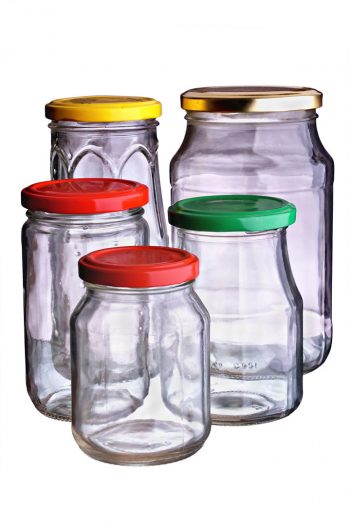
Rigid Plastics
- Food jars, tubs (lids on)
- Clear food containers/clamshells (e.g. from berries, mixed greens)
- Disposable plates, cups
- Beverage bottles (lids on)
- Detergent, soap, shampoo bottles (lids/sprayers/pumps on)
- Clear CD/DVD cases (empty; black cases are garbage)
Note: all black and/or compostable plastic goes in the garbage.
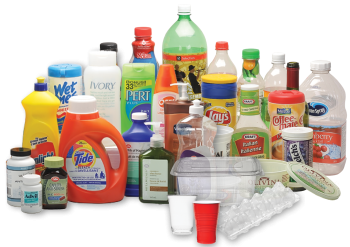
Soft, Stretchy Plastics
- Grocery/retail shopping bags
- Produce/bulk food bags
- Bread bags (non-foil)
- Milk bags (outer bag, rinsed inner pouches)
- Sandwich bags (including resealable)
- Frozen fruit/vegetable bags (no stand-up pouches)
- Over-wrap (e.g. from toilet paper, napkins, paper towels, water/soft drink cases)
- Newspaper/flyer/magazine bags (separate paper from bag, recycle separately)
- Dry cleaning bags
- Diaper/feminine hygiene outer bags
- Garden soil/manure/compost/road salt bags
Note: remove product before recycling.
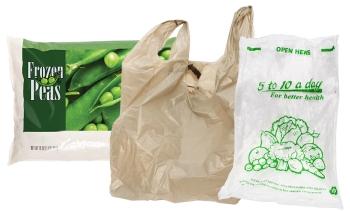
Metal
- Aluminum/steel food & beverage cans
- Aluminum trays, burner liners, pie plates, roasting pans
- Cookie tins
- Aerosol cans (empty; lids on)
- Paint cans (empty; remove lids and recycle separately)
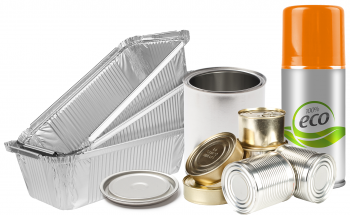
Paper*
- Bags (without wax or plastic lining/coating)
- Advertising mail, fine paper, envelopes
- Newspapers, flyers, directories, magazines, catalogues (remove over-wrap, recycle separately)
- Gift wrap, tissue paper, cards (no ribbons, bows, foil wrap)
- Shredded paper (put in clear plastic bag, tie closed)
- Soft/hard cover books
*Place pieces smaller than a business card in envelope or add to bag of shredded paper.
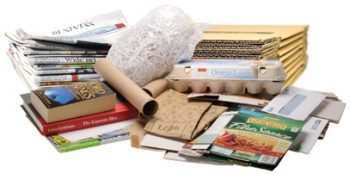
Paper Containers
- Cartons and boxes (e.g. from juice, milk, soup; straws are garbage)
- Spiral wound cans (e.g. from chips, nuts, frozen juice – place metal end in can and pinch closed; pull-off strips are garbage)
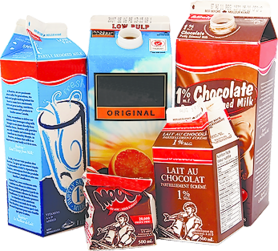
Cardboard
- Boxboard (e.g. from cereal, tissue, detergent, shoe; remove liners, flatten, no freezer boxes)
- Corrugated cardboard (unwaxed, flattened; pizza boxes must be empty; remove over-wrap from water/soft drink cases, recycle separately)
- Rolls (e.g. from toilet paper, paper towel, wrapping paper)
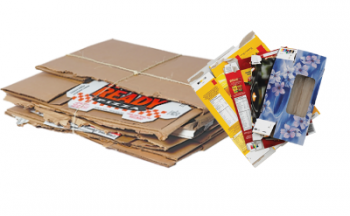
Foam Polystyrene
- Foam food and protective packaging (e.g. plates, cups, egg cartons, takeout containers, meat/fish trays; plastic wrap & absorbent pad are garbage)
- Protective packaging (e.g. from shipping, electronics; foam packaging peanuts are garbage)
Note: Food/drink packaging must be empty and rinsed (otherwise, place in garbage). Black foam items and pieces smaller than 10 cm (4″) x 10 cm (4″) go in the garbage).
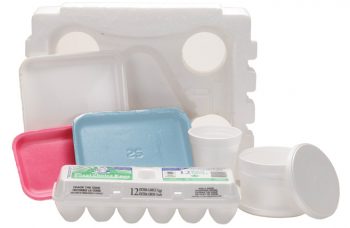
Items Not Accepted in the Blue Bin (Recycling)

Medical, Home Healthcare & Personal Protective Equipment Waste
- Needles and syringes are Household Hazardous Waste.
- Place the following inside two plastic bags and then in the garbage:
- Disposable masks, gloves, gowns, pads
- Soiled dressing, sponges, gauze
- Catheters & colostomy bags
- IV bags & tubing
- Dialysis waste
Household Hazardous Waste
- Household hazardous waste items such as propane/helium tanks, batteries, compact fluorescent light bulbs, pesticides, paint, etc. must never be put in recycling or garbage.
- Take to a Drop-Off Depot or for amounts between 10 to 50 litres/kilograms, book a free Toxic Taxi pickup online or by calling 311.
Plastic Packaging
- Any items that are black, including takeout containers, bags, plant trays and flower pots
- Any items that are labelled or marketed as compostable or biodegradable, including bags, containers, cutlery
- Stand-up resealable pouch bags
- Liner bags (e.g. from cereal, cookies, crackers)
- Wrapping around pre-packaged foods like meat and cheese
- Food wrap (i.e. Cling wrap)
- Bubble wrap
- Squeeze tubes for home and personal products (e.g. from toothpaste, lotion)
- Paint cans
Other Plastic
- Straws
- Clothes hangers
- Binders
- Toys
- Cassettes, CDs, DVDs
Glass
- Drinking glasses, dishes, cups, crystal
- Ceramics, pottery
- Window glass
- Light bulbs
- Mirrors
- Pots, pans
Metal
- Tools, scrap metal, auto parts
- Clothes hangers
- Pots, pans
- Small appliances (e.g. kettles, toasters, hair dryer)
- Electronics
Aluminum
- Foil food wrap, potato chip bags
- Blister packs (e.g. from gum, pills)
- Metallic gift wrap and bows
Textiles
- Clothes, shoes
- Carpets, curtains
- Bedding
Paper Products
- Tissues, napkins, paper towels
- Beverage cups
- Frozen food boxes (they have a lining or coating)
- Waxed cardboard
- Any paper with wax or plastic lining or coating
Other Items
- Cables, hoses, ropes
- Wood (e.g. fruit crates, chopsticks)
- Renovation waste (must be taken to a Drop-Off Depot)
Why We Can't Take Certain Items in the Blue Bin
General Recycling Instructions
- Put items in loose and not bagged. Use a clear plastic bag only if necessary.
- Prepare containers in 3 easy steps:
- empty food, liquids or other contents
- rinse to remove any residue
- place lid/cap on (including sprayers and pumps)
- Place all black and/or compostable plastic (e.g. food containers, bags, cutlery) in the garbage.
- Flexible multi-layered packaging (e.g. stand-up pouches) and plastic-lined paper
(e.g. instant oatmeal packs) go in the garbage. To check if paper is lined with plastic, rip it slowly. If you see any plastic lining, the item goes in the garbage. - Separate plastic bags/over-wrap from newspapers, flyers, magazines, water/soft drink cases. Recycle separately.
- Put shredded paper in a clear plastic bag.
- Put pieces of paper the size of a business card or smaller in an envelope or add to clear bag of shredded paper.
- Put foam pieces smaller than 10 cm (4″) x 10 cm (4″) in the garbage.
- Not all items with a recycling symbol
 are accepted in Toronto's Blue Bin recycling program.
are accepted in Toronto's Blue Bin recycling program. - If unsure about whether or not an item can be recycled, check Waste Wizard.
Common Recycling Mistakes
Food and organic waste
Food scraps like apple cores, eggshells or expired leftovers belong in your Green Bin. When you mistakenly toss food scraps in your Blue Bin, food residue and particles get soaked up by paper and can ruin large batches of otherwise good recyclables.
Containers with leftover food
Please empty and rinse food containers before tossing them in your Blue Bin. When you don't, the residue from items like jars and take-out containers gets soaked up by paper and can ruin large batches of otherwise good recyclables. Put any food scraps in your Green Bin.
Clothing and textiles
Old clothes, shoes, blankets, and curtains don't belong in the Blue Bin. They can get caught in sorting machines, damage equipment and cause workplace injuries at the recycling facility. Instead, donate items that are in good condition to not-for-profit agencies or drop them off for reuse at Community Environment Days. If your items can't be donated, put them in the garbage.
Hot beverage cups
Most disposable hot beverage cups are made of paper, but lined with plastic, which makes them difficult to sort mechanically at the recycling facility. Conventional paper mills do not want coffee cups because of their low-quality paper and inner liner, which does not pulp easily and causes clogging in the pulping process. The dyes in the paper can also affect the quality of the end paper product and make it difficult for paper mills to turn cups into other paper-based products. As a result, the City has not been able to find a stable market (i.e. buyers) for coffee cups. Please place coffee cups in the garbage. Non-black plastic lids and paper sleeves should be removed and placed in the Blue Bin.
Black plastic
Black plastic of any kind, such as take-out containers and black garbage bags, is not accepted in the City's recycling program. There are two main reasons for this:
- there is no stable market for the volume of black plastic generated in Toronto
- black plastic cannot be sorted mechanically at the recycling facility because the optical sorting technology cannot recognize it.
Please dispose of all black plastic in the garbage.
VHS tapes, chains, hoses and electrical cords
These do not go in your Blue Bin. They can get tangled in sorting machines, damage equipment and cause workplace injuries at the recycling facility. Donate unwanted VHS tapes or see if your local electronics store's has a recycling program. Throw unwanted cords, hoses and cables in your garbage.
Important Information About Coffee Pods and Compostable and Biodegradable Items
Coffee pods
The City does not accept coffee pods in its Blue Bin recycling program, as coffee grounds are often left within them, which can ruin other items in the bin, such as paper and cardboard, making them no longer recyclable. All coffee pods, including those that are labelled or marketed as recyclable, must be disposed of in the garbage or returned to retailers/manufacturers who have take-back programs.
The City commissioned research related to disposal of single-serve coffee and tea pods. The findings include feedback from Toronto residents about use, attitudes and disposal behaviours.
Compostable and biodegradable items
The City does not accept the following items marketed or labelled as compostable or biodegradable in its Blue Bin recycling program:
- containers/packaging
- coffee pods
- coffee cups
- bags
- cutlery
These items, which may be made of or lined with a bio-based plastic, must be disposed of in the garbage. Alternatively, products can be returned to retailers/manufacturers who have take-back programs.
Why the City doesn't accept compostable and biodegradable items in the Blue Bin
Compostable and biodegradable plastics are not recyclable, as they are made of materials that are meant to break down versus materials that can be made into something new. Once recyclables are collected and sorted, they are baled and sold to partially offset the cost of collecting and separating recycling. At the recycling facility, compostable and biodegradable plastics get mixed with conventional plastics. When this happens, it lowers the quality of the plastic bales making them less valuable and more difficult to sell.
What Happens to Recycling?
Recycling is collected from the curb or a building and brought to one of the City's Transfer Stations. From there, it is loaded onto tractor-trailers and brought to a Material Recovery Facility in Toronto owned by Green For Life Environmental Inc., which the City contracts to process its recycling.
Once at the Material Recovery Facility, the recycling is manually and mechanically sorted – using a series of belts and conveyors, screens, magnets, optical sorting and AI systems – into the different types of materials, such as plastics, paper, aluminum and glass. The different types of materials are then baled and sold to re-processors/markets to be made into something new. The money that the City gets from the sale of recyclables is only enough to partially offset the cost to run the recycling program.
The City of Toronto's recycling system remains strong. The majority of the items put in the Blue Bin that are supposed to be there (i.e. accepted in the program) are recovered and shipped to markets to be made into something new.
Transition of the Recycling Program to Extended Producer Responsibility
Extended Producer Responsibility (EPR)
- On June 3, 2021 the Province of Ontario finalized the regulation to transition Ontario's Blue Box Program to full EPR. Amendments to the regulation were published on April 19, 2022.
- EPR will make producers fully accountable for the packaging and paper they put into the Ontario marketplace and shift the operational and financial responsibilities of recycling away from municipalities.
- Ontario municipalities will transition their Blue Box Programs to EPR between July 1, 2023 and December 31, 2025.
Toronto's transition to EPR
- The City of Toronto will be one of the first municipalities to transition to EPR in year one on July 1, 2023.
- Toronto residents should not experience any changes to their Blue Bin recycling program during the transition years (2023 – 2025).
- The greatest change to the City's integrated waste management system will take place in 2026 when producers have fully taken over all municipal Blue Box programs and begin to implement a standardized program.
- The City has established a dedicated EPR team and is actively working to prepare for Toronto's transition.
- There are still a number of unknowns related to EPR, including:
- what the overall recycling system will look like
- what the City's role will be in the transition years and beyond
- the resulting impacts to the City and Toronto residents.
Benefits of EPR
The benefits of EPR include:
- standardization of what is accepted in the Blue Box across the province as of 2026 when producers have fully taken over recycling.
- potential reduction and/or innovation in packaging
- cost savings for the City
- potential for increased waste diversion from landfill once recovery targets come into effect in 2026 and onwards.
EPR next steps
- In the near future, producers will begin to design what the standardized Blue Box Program will look like in 2026 after all municipal programs have transitioned.
- The City has been advocating for the best interests of Toronto and its residents throughout the development of the regulation and will continue to do so throughout the development of the new system and transition to EPR.
- Solid Waste Management Services will report back to City Council in 2022, once the Blue Box Program details become available and the impacts to Toronto's integrated waste management system are better understood.
Recycling Beverage Container Pilot in Parks
In spring 2021, the City of Toronto installed new lids on 300 recycling bins in parks across the city. The new bin lids have a hole to exclusively capture empty beverage cans and bottles. Stickers adhered to the bins and signage beside the bins indicate what items are accepted and not accepted in the recycling bins.
While the City works to divert as much waste as possible from landfill, the material in public recycling bins is often heavily contaminated with non-recyclable items, such as containers with food and liquid in them, coffee cups, black plastic and pet waste. When this happens, much of the recycling is ruined, sending it to landfill.
The goal of this pilot project is to increase the amount of material the City can recycle from parks. Data collected from the pilot will be used to determine whether dedicated bins for bottles and cans can contribute to a long-term strategy to reduce contamination and increase the amount of recycling collected from park bins.
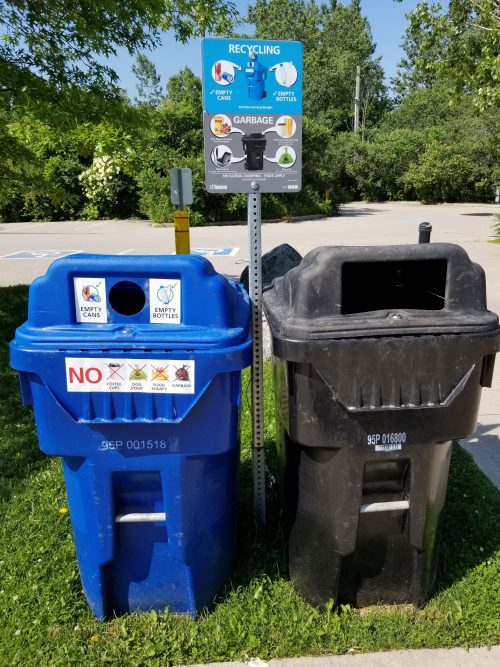
Source: https://www.toronto.ca/services-payments/recycling-organics-garbage/houses/what-goes-in-my-blue-bin/
0 Response to "What Can You Put in the Blue Recycling Bin"
Post a Comment